Monday, March 5, 2018
 (March 7, 2018) — “Sales of retail propane trucks always have their peaks and valleys,” says Brian Amthor, executive vice president at Amthor International Inc. (Gretna, Va.). “The last couple of years were valleys, but we’re now making a move back up to the peak.” All of the truck builders BPN spoke with recently described sales as being back on the rise and there are several factors in play. “We’ve really had the perfect storm,” says Scott Swensen, sales representative of Lin’s Propane Trucks (Dighton, Mass.), and December’s Bomb Cyclone that sunk temperatures well below zero during the last half of that month was only part of the storm Swensen was referring to.
(March 7, 2018) — “Sales of retail propane trucks always have their peaks and valleys,” says Brian Amthor, executive vice president at Amthor International Inc. (Gretna, Va.). “The last couple of years were valleys, but we’re now making a move back up to the peak.” All of the truck builders BPN spoke with recently described sales as being back on the rise and there are several factors in play. “We’ve really had the perfect storm,” says Scott Swensen, sales representative of Lin’s Propane Trucks (Dighton, Mass.), and December’s Bomb Cyclone that sunk temperatures well below zero during the last half of that month was only part of the storm Swensen was referring to.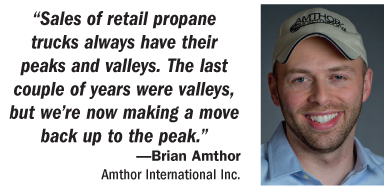
“The cold weather is certainly a factor,” comments Tim Schweppe, Arrow Tank & Engineering Co.’s general manager for the propane division (Minneapolis). “But, we started to see inquiries pick up during an above-normal fall for dryer gas in the areas around Minnesota.”
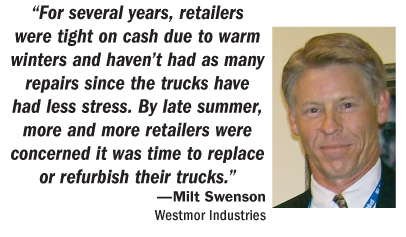
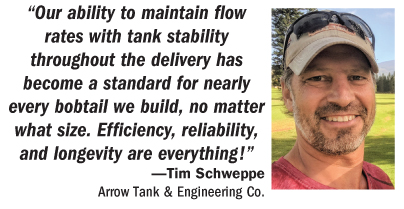 Both Schweppe and Milt Swenson, truck and trailer division sales manager at Westmor Industries (Morris, Minn.), saw interest in new trucks start to pick up in early fall, which they attribute not only to crop drying but also to overall pent-up demand for newer trucks. “For several years, retailers were tight on cash due to warm winters and haven’t had as many repairs since the trucks have had less stress. By late summer, more and more retailers were concerned it was time to replace or refurbish their trucks,” Swenson said. “A third aspect is that since last fall’s elections, the attitude about the business climate is better.”
Both Schweppe and Milt Swenson, truck and trailer division sales manager at Westmor Industries (Morris, Minn.), saw interest in new trucks start to pick up in early fall, which they attribute not only to crop drying but also to overall pent-up demand for newer trucks. “For several years, retailers were tight on cash due to warm winters and haven’t had as many repairs since the trucks have had less stress. By late summer, more and more retailers were concerned it was time to replace or refurbish their trucks,” Swenson said. “A third aspect is that since last fall’s elections, the attitude about the business climate is better.”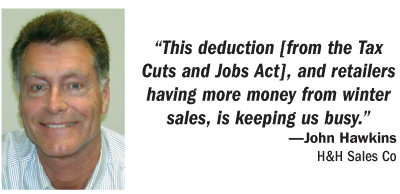
The attitude improved further near the end of 2017 with the passage and signing into law of the Tax Cuts and Jobs Act, which, among other things, increased the deduction limit for qualifying equipment and software purchased or financed during the tax year from $510,000 in 2017 to $1 million in 2018 and beyond. “Larger propane dealers are able to buy a lot more equipment and take advantage of this deduction,” said John Hawkins, CEO of H&H Sales Co. (Huntertown, Ind.). “This deduction [from the Tax Cuts and Jobs Act], and retailers having more money from winter sales, is keeping us busy.”
Nathan Roberts of Fisk Tank Carrier (Columbus, Wis.) is pleased with recent business activity. “Sales have gone to crazy high volumes. In the past 10 days, I’ve sold seven trucks to seven different companies,” he adds. “That’s amazing considering how slow sales were last year.” Industry veteran Joe Rose, who joined Lin’s Propane Trucks (Dighton, Mass.) recently, gives the credit for increased sales to Mother Nature. “We have many more trucks on order than last year. We’re off to a great start in 2018.” Rose advises retailers contemplating the purchase of a new truck or trucks to get on the list. “We are able to do a lot of trucks, but we are getting booked further and further out and we hate to disappoint our customers.”
Go Big or Go Home
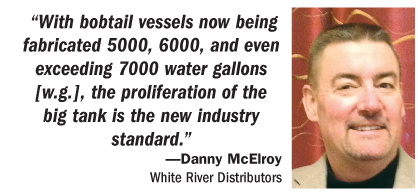 It’s not just more trucks being purchased, it’s bigger trucks with more features. “The recent trend for bobtails in the propane industry has been ‘go big or go home,’” Danny McElroy, executive vice president/general manager of White River Distributor’s Southwest Sales (Dallas), explains. “With bobtail vessels now being fabricated 5000, 6000, and even exceeding 7000 water gallons [w.g.], the proliferation of the big tank is the new industry standard.” But the big tanks come with a price, he notes. “Add on the 12% federal excise tax to the price tag and you have got one expensive bobtail. That 12% tax is why the old standard in the industry kept the tanks below 3500 w.g. and on a single axle.” McElroy adds that although tanks 3500 gallons or a little less are still the bulk of the builds, White River Distributors is also seeing a market trend to smaller, more maneuverable bobtails with vessels ranging from 750 to 1600 w.g. “We have a multitude of customers wanting a four-wheel-drive chassis and a bobtail that can get in the tough, rugged areas where the big boys can’t tread.”
It’s not just more trucks being purchased, it’s bigger trucks with more features. “The recent trend for bobtails in the propane industry has been ‘go big or go home,’” Danny McElroy, executive vice president/general manager of White River Distributor’s Southwest Sales (Dallas), explains. “With bobtail vessels now being fabricated 5000, 6000, and even exceeding 7000 water gallons [w.g.], the proliferation of the big tank is the new industry standard.” But the big tanks come with a price, he notes. “Add on the 12% federal excise tax to the price tag and you have got one expensive bobtail. That 12% tax is why the old standard in the industry kept the tanks below 3500 w.g. and on a single axle.” McElroy adds that although tanks 3500 gallons or a little less are still the bulk of the builds, White River Distributors is also seeing a market trend to smaller, more maneuverable bobtails with vessels ranging from 750 to 1600 w.g. “We have a multitude of customers wanting a four-wheel-drive chassis and a bobtail that can get in the tough, rugged areas where the big boys can’t tread.”According to McElroy, his company recently delivered several 1200-w.g. vessels on four-wheel-drive Ford F-550s and Dodge 5500s in New Mexico. “We are now in the process of a build for a customer in Upstate New York with a 1600-w.g. vessel and a 1320-w.g. vessel for another customer in Arizona. With our special relationship with National Tank in Hernando, Miss., we will continue to build custom tanks of all sizes to accommodate the many different needs of the retail propane marketer.”

Why are propane retailers willing to pay more for the bigger trucks? “There had been concern that larger bobtails would damage driveways and be harder to maneuver,” said Kurtz Truck Equipment’s (Marathon, N.Y.) vice president of sales and marketing Roger Smith. “Once companies began to see that these concerns were overblown, the interest in 5000-gal. vessels and larger began to take off.” Smith notes that a key benefit to the larger bobtails is that drivers of smaller vessels will often run out of gas mid-afternoon far from the bulk tank and have dead time near the end of the day. He also notes that retail propane marketers are becoming more willing to invest in other features that enhance efficiency. “Multiple hose reels are becoming more and more common on a bobtail. Now drivers with three hose reels can fill three autogas vehicles all at the same time.”

Joey Runnels, a sales representative at Mississippi Tank Co. (Hattiesburg, Miss.), cautioned that even though the larger bobtails are becoming more accepted, retail propane marketers need to carefully assess the roads and bridges the truck will travel before buying. “The geography and the infrastructure of the travel area needs to be considered before making the purchase. It may make sense to use a larger truck in some areas, and a smaller truck in more rugged areas. The larger vessel is certainly perfect for larger commercial and industrial accounts with wider roads and bridges on their route.” Mike VandenBoom, president of Signature Truck Systems (Clio, Mich.), added, “Bobtails are definitely changing and the needs can be as geographical as pure overall efficiency. Marketers in mountainous regions are cautious to manage their gross weight-to-power balance. But, overall, there is growing interest in larger bobtail trucks.”
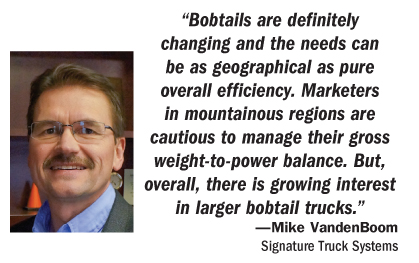
Schweppe adds, “Our customers have observed the need to upgrade their equipment to serve the customer’s needs. Our MO-FLO product lineup provides more bobtails with more flow to get the job done.” According to the Arrow Tank & Engineering general manager, the typical build for this job is 5300 gallons up to 6700 gallons with flow rates of 80 gpm up to 120 gpm, depending upon what the customer needs. “Our ability to maintain flow rates with tank stability throughout the delivery has become a standard for nearly every bobtail we build, no matter what size. Efficiency, reliability, and longevity are everything!”
 Steve Bloomstrand, sales and marketing manager of Rocket Supply (Roberts, Ill.), is also seeing more and more independent retail propane marketers in his area stepping up to bobtails that haul 5000-plus gallons, and said concerns with driveway damage and maneuverability have not turned out to be major problems. “In addition, these marketers are also liking features such as the automatic hose reel-out. Larger cabs are in higher demand.” Schweppe concurs. “Never in my wildest dreams did I expect to be building extended cabs for stock — moreover 5300-gallon extended cabs. Bobtails and operators are expected to work their hardest in the harshest environments. Added space and an air-ride cab could possibly help attract and retain drivers, which is a difficult task these days.”
Steve Bloomstrand, sales and marketing manager of Rocket Supply (Roberts, Ill.), is also seeing more and more independent retail propane marketers in his area stepping up to bobtails that haul 5000-plus gallons, and said concerns with driveway damage and maneuverability have not turned out to be major problems. “In addition, these marketers are also liking features such as the automatic hose reel-out. Larger cabs are in higher demand.” Schweppe concurs. “Never in my wildest dreams did I expect to be building extended cabs for stock — moreover 5300-gallon extended cabs. Bobtails and operators are expected to work their hardest in the harshest environments. Added space and an air-ride cab could possibly help attract and retain drivers, which is a difficult task these days.”Features for Creature Comforts
 Larger cab size for bobtail trucks is just one of many features unheard of just a few years ago. Wayne Terpstra of Utility 1 Source (Kansas City, Mo.) notes efficiency and driver comfort are big benefits buyers now seek to attract and keep drivers. “They want ease of use for electronic devices to communicate in real-time to the office. They want employees to be able to utilize state-of-the-art hand-held electronics to maximize efficiency, and they want it to be a comfortable process,” he said. “The company is wanting to reduce office staff and wasted delivery miles. They want billing to be instantaneous.” Rob Vandemark, who runs the truck division at Industrial Propane Service Inc. (IPS; Byron, Mich.), agrees. “There are many in-cab electronic solutions to choose from now. Bobtails equipped to work well with few interface issues are in demand,” he explained.
Larger cab size for bobtail trucks is just one of many features unheard of just a few years ago. Wayne Terpstra of Utility 1 Source (Kansas City, Mo.) notes efficiency and driver comfort are big benefits buyers now seek to attract and keep drivers. “They want ease of use for electronic devices to communicate in real-time to the office. They want employees to be able to utilize state-of-the-art hand-held electronics to maximize efficiency, and they want it to be a comfortable process,” he said. “The company is wanting to reduce office staff and wasted delivery miles. They want billing to be instantaneous.” Rob Vandemark, who runs the truck division at Industrial Propane Service Inc. (IPS; Byron, Mich.), agrees. “There are many in-cab electronic solutions to choose from now. Bobtails equipped to work well with few interface issues are in demand,” he explained.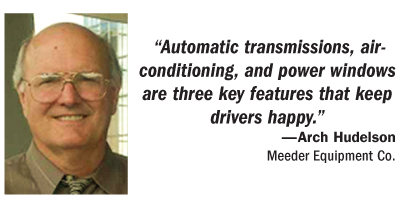
An automatic transmission is one more benefit drivers like, according to Arch Hudelson, special projects director at Meeder Equipment Co. (Fresno, Calif.). “Automatic transmissions, air-conditioning, and power windows are three key features that keep drivers happy.” Bloomstrand of Rocket Supply mentioned rear-vision camera systems and power mirrors as two more features drivers like, while Hawkins of H&H Sales listed 110-volt systems to power cell phones and laptops. Brian Amthor indicated that trucks with the capacity to carry a lot of tool boxes is an added benefit, especially if the tool boxes can all be locked down with the click of a button. Bluetooth audio is another newly sought feature, Fisk Tank Carrier’s Roberts added.
 Multi-Purpose and Low-Maintenance
Multi-Purpose and Low-MaintenanceMost of the company representatives BPN spoke with explained there are many instances where retail propane companies were willing to invest more in their trucks in exchange for the payout of improved efficiency and less maintenance and repair costs. Hawkins of H&H Sales noted that many retailers are spending more money on trucks that can perform multiple functions, such as bobtails that are also equipped to deliver cylinders. Roberts said many are willing to buy larger trucks that can haul two 1000-gal. tanks side-by-side. This helps guarantee the company can always work off one truck to set two tanks per day without having a long drive back to the plant mid-day to get the second tank. “We’re building trucks lighter with aluminum platform tailgates and aluminum is used more in the construction of the body,” Hawkins observed. “The lighter the truck, the more cylinders it can be allowed to haul.” In addition, some prefer truck beds 14 feet in length because it allows an entire 1000-gal. tank to sit on the bed rather than a portion hanging off the back.
“Our service trucks have evolved through direct input from both customers and our ‘propane guys’ who build them,” said Bruce Whitney, vice president at Signature Truck Systems and Granby Industries Propane Group (Clio, Mich.). “New cabinet designs unique to us include cabinets to protect copper and plastic pipe, [which resulted] from customer input. And we have hidden a drawer in the truck frame to hold risers that otherwise can become damaged.”

“From a maintenance standpoint, I think retailers are seeing the big picture now better than before about the value of paying for better products and to avoid costly repairs and downtime in the dead of winter,” said Swensen of Lin’s Propane Trucks. “We see more people spending an extra $400 here and there on features that could save them $2000 or more for repairs, plus downtime, later. Flange valves are an example, since they make repairs easier and are less prone to leaks than threaded valves. We’ve seen a move from carbon steel to stainless steel, which lasts longer.” Smith of Kurtz Truck Equipment mentioned that many companies like Marshall Excelsior’s new product that doesn’t allow a truck to move if the hose is not in place.
Financing and Renting
Most companies acknowledged there are more lease-to-own options than ever before. Some are offered in-house directly to customers and some are offered by third-party vendors such as Vision Financial Group (VFG; Pittsburgh). Another concept mentioned by Westmor’s Swenson and Terpstra of Utility 1 Source is an option to rent propane bobtails and service trucks. “We have 20 trucks for this specific purpose and 18 of them are rented out right now,” Terpstra noted. “This allows companies to have the trucks they need, when they need them, without having to immediately make a huge capital investment. They can simply return the vehicle when they don’t need it anymore.”

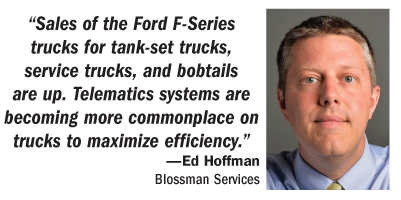
Propane trucks fueled by propane are not a new innovation, but new engine technology is making them a better option than ever before, according to Ed Hoffman, president of Blossman Services (Ocean Springs, Miss.). “Sales of the Ford F-Series trucks for tank-set trucks, service trucks, and bobtails are up,” he said. “Telematics systems are becoming more commonplace on trucks to maximize efficiency.” Hoffman believes more and more retailers will ultimately move toward propane-fueled trucks. “Meter systems such as BASE, Cargas, and Raven are also improving efficiency with routing,” said Runnels of Mississippi Tank.

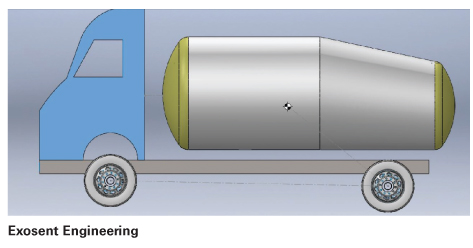
A bobtail with a whole new shape is now being offered by Exosent Engineering (College Station, Texas). According to director of business development Gerald Pearson, the new bobtails are shaped to have a lower center of gravity, adding to safety by reducing the likelihood of rollovers. “The cone shape also reduces the slosh factor,” Pearson added. “Insurance companies are giving incentives for using this truck.” A few years ago, Exosent also developed a transport trailer with a similar shape and a lower center of gravity.
With warmer weather and trade shows around the corner, it does make sense to beat the rest of the herd and get orders in for new trucks to be prepared for next winter. —Pat Thornton

